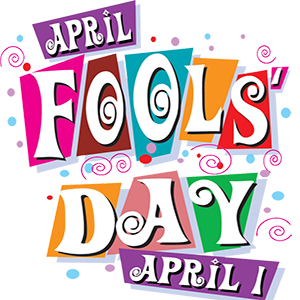What should we know about April Fools' Day? - Mit kell tudnunk a bolondok napjáról?

Let's have a look at April Fools' Day.
April Fools' Day (sometimes called All Fools' Day) is celebrated every year on 1 April. People often play practical jokes or spread hoaxes. The jokes and their victims are called April fools. Some newspapers, magazines, and other published media report fake stories, which are usually explained the next day or below the news section in small letters. Although popular since the 19th century, the day is not a public holiday in any country.
1. Practical jokes
- to completely block someone's doorway with phonebooks
- to push a car into a building
- to put a thumbtack on someone's chair
- to put a fake vomit on someone's desk
2. Hoaxes
- In 2009 The Swiss Tourism Board released a video that revealed the secret of why their mountains look so clean. It was due to the hard work of the Association of Swiss Mountain Cleaners, whose members daily scaled the Alps, scrubbing the rocks of unsightly bird droppings.
- In 1998 Burger King published a full page advertisement in USA Today announcing the introduction of a new item to their menu: a "Left-Handed Whopper" specially designed for the 32 million left-handed Americans. According to the advertisement, the new whopper included the same ingredients as the original Whopper (lettuce, tomato, hamburger patty, etc.), but all the condiments were rotated 180 degrees for the benefit of their left-handed customers. The following day Burger King issued a follow-up release revealing that although the Left-Handed Whopper was a hoax, thousands of customers had gone into restaurants to request the new sandwich.
- In 1998 issue of the New Mexicans for Science and Reason newsletter contained an article claiming that the Alabama state legislature had voted to change the value of the mathematical constant pi from 3.14159 to the 'Biblical value' of 3.0. Soon the article made its way onto the internet, and then it rapidly spread around the world, forwarded by email. It only became apparent how far the article had spread when the Alabama legislature began receiving hundreds of calls from people protesting the legislation.
- In 1957 The respected BBC news show Panorama announced that thanks to a very mild winter and the virtual elimination of the dreaded spaghetti weevil, Swiss farmers were enjoying a bumper spaghetti crop. It accompanied this announcement with footage of Swiss peasants pulling strands of spaghetti down from trees. Huge numbers of viewers were taken in. Many called the BBC wanting to know how they could grow their own spaghetti tree. To this the BBC diplomatically replied, "place a sprig of spaghetti in a tin of tomato sauce and hope for the best." Even the director-general of the BBC later admitted that after seeing the show he checked in an encyclopedia to find out if that was how spaghetti actually grew (but the encyclopedia had no information on the topic). The broadcast remains, by far, the most popular and widely acclaimed April Fool's Day hoax ever.
- In 1950 Motorists driving along the scenic Rim of the World highway near Lake Arrowhead in Southern California encountered something remarkable. All the pine and cedar trees lining the road had grown oranges overnight. The transformation turned out to be the work of the residents of the nearby town of Skyforest, led by the cartoonist Frank Adams. They had crept out during the night and strung 50,000 oranges in the trees along a one-mile section of the highway. The fruit was left over from the recent National Orange Show in San Bernardino.
3. Pranks
- attach an airhorn to their seat
- create an infinite loop of shopping carts around their car
- plant a grass garden in your coworker's keyboard
- make Mentos ice cubes for your friends that love soda
- Paint soap with clear nail polish and leave it in the shower
- Finally, here is my favourite prank:
Happy Fools' Day! If you have a good joke or prank, please share with us on our Facebook channel!
